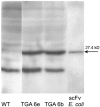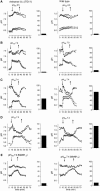The Galpha protein controls a pH-dependent signal path to the induction of phytoalexin biosynthesis in Eschscholzia californica
- PMID: 16679461
- PMCID: PMC1475490
- DOI: 10.1105/tpc.105.035121
The Galpha protein controls a pH-dependent signal path to the induction of phytoalexin biosynthesis in Eschscholzia californica
Abstract
The function of a Galpha protein in the elicitation of phytoalexin (benzophenanthridine) biosynthesis was characterized in cultured cells of California poppy (Eschscholzia californica). Both the decrease of Galpha content via antisense transformation and the expression of recombinant anti-Galpha single-chain antibodies strongly impaired the induction of alkaloid biosynthesis by low elicitor concentrations. All transgenic cell types were deficient in two elicitor-triggered early signal events: activation of phospholipase A2 (PLA2) and efflux of vacuolar protons. The lacking H+ efflux could be restored (1) by adding lysophosphatidylcholine (LPC), a product of PLA2 activity, to vacuoles in situ and (2) by exposing intact cells to isotonic, near-neutral HEPES buffers. The latter treatment induced alkaloid biosynthesis in the absence of elicitor and in Galpha-deficient cells. We conclude that Galpha mediates the stimulation of PLA2 by low elicitor concentrations and that the resulting peak of LPC initiates a transient efflux of vacuolar protons. In this way, an acidic peak of the cytoplasmic pH is generated that causes the expression of enzymes of phytoalexin production independent of the hypersensitive response.
Figures












Similar articles
-
The Vacuolar Proton-Cation Exchanger EcNHX1 Generates pH Signals for the Expression of Secondary Metabolism in Eschscholzia californica.Plant Physiol. 2016 Feb;170(2):1135-48. doi: 10.1104/pp.15.01570. Epub 2015 Nov 17. Plant Physiol. 2016. PMID: 26578709 Free PMC article.
-
Intracellular pH signals in the induction of secondary pathways--the case of Eschscholzia californica.J Plant Physiol. 2006 Feb;163(3):369-81. doi: 10.1016/j.jplph.2005.11.012. Epub 2006 Jan 4. J Plant Physiol. 2006. PMID: 16413947
-
Elicitor-activated phospholipase A(2) generates lysophosphatidylcholines that mobilize the vacuolar H(+) pool for pH signaling via the activation of Na(+)-dependent proton fluxes.Plant Cell. 2002 Jul;14(7):1509-25. doi: 10.1105/tpc.002329. Plant Cell. 2002. PMID: 12119371 Free PMC article.
-
Perception and transduction of an elicitor signal in cultured parsley cells.Biochem Soc Symp. 1994;60:173-82. Biochem Soc Symp. 1994. PMID: 7639778 Review.
-
Signal transduction in elicitation of phytoalexin synthesis.Biochem Soc Trans. 1994 May;22(2):414-9. doi: 10.1042/bst0220414. Biochem Soc Trans. 1994. PMID: 7958336 Review. No abstract available.
Cited by
-
"Self" and "non-self" in the control of phytoalexin biosynthesis: plant phospholipases A2 with alkaloid-specific molecular fingerprints.Plant Cell. 2015 Feb;27(2):448-62. doi: 10.1105/tpc.114.135343. Epub 2015 Feb 10. Plant Cell. 2015. PMID: 25670767 Free PMC article.
-
The salt stress-induced LPA response in Chlamydomonas is produced via PLA₂ hydrolysis of DGK-generated phosphatidic acid.J Lipid Res. 2011 Nov;52(11):2012-20. doi: 10.1194/jlr.M016873. Epub 2011 Sep 6. J Lipid Res. 2011. PMID: 21900174 Free PMC article.
-
Plant phospholipid signaling: "in a nutshell".J Lipid Res. 2009 Apr;50 Suppl(Suppl):S260-5. doi: 10.1194/jlr.R800098-JLR200. Epub 2008 Dec 20. J Lipid Res. 2009. PMID: 19098305 Free PMC article.
-
The signal molecule lysophosphatidylcholine in Eschscholzia californica is rapidly metabolized by reacylation.Planta. 2008 Dec;229(1):183-91. doi: 10.1007/s00425-008-0819-9. Epub 2008 Sep 20. Planta. 2008. PMID: 18807068
-
The Vacuolar Proton-Cation Exchanger EcNHX1 Generates pH Signals for the Expression of Secondary Metabolism in Eschscholzia californica.Plant Physiol. 2016 Feb;170(2):1135-48. doi: 10.1104/pp.15.01570. Epub 2015 Nov 17. Plant Physiol. 2016. PMID: 26578709 Free PMC article.
References
-
- Aharon, G.S., Gelli, A., Snedden, W.A., and Blumwald, E. (1998). Activation of a plant plasma membrane Ca2+ channel by TG α1, a heterotrimeric G protein alpha-subunit homologue. FEBS Lett. 424 17–21. - PubMed
-
- Armero, J., and Tena, M. (2001). Possible role of plasma membrane H+-ATPase in the elicitation of phytoalexin and related isoflavone root secretion in chickpea (Cicer arietinum L.) seedlings. Plant Sci. 161 791–798.
-
- Artsaenko, O., Peisker, M., zur Nieden, U., Fiedler, U., Weiler, E.W., Müntz, K., and Conrad, U. (1995). Expression of a single chain Fv antibody against abscisic acid creates a wilty phenotype in transgenic tobacco. Plant J. 8 745–750. - PubMed
-
- Artsaenko, O., Philipps, J., Fiedler, U., and Peisker, M., and Conrad, U. (1999). Intracellular immunomodulation in plants: A new tool for the investigation of phytohormones. In Recombinant Antibodies: Applications in Plant Science and Plant Pathology, K. Harper and A. Ziegler, eds (London: Taylor & Francis), pp. 145–156.
Publication types
MeSH terms
Substances
LinkOut - more resources
Full Text Sources

